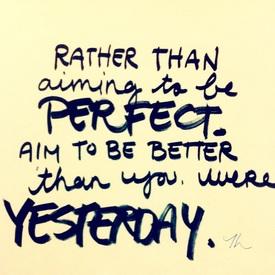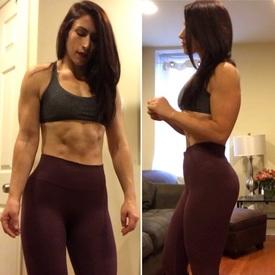Crossfit for Heavier Beginners?

JnineGains
Posts: 136 Member
Is it do able or should I wait until I drop some weight first?
0
Replies
-
It is doable! Most all crossfit can be scaled to accommodate anyones ability level. No better time than the present to get started!2
-
It is definitely doable. Talk to and research the places you are thinking about going to and that should make you feel a bit more comfortable about starting. It's scalable for any fitness level1
-
Do it!!1
-
do it1
-
Totally do-able. I don't CF anymore, but I did it for about three years and my gym had all types of people getting great workouts. You'll see a lot a people who have the typical "cf look", but you'll also see a TON of people who are older, heavier, more out of shape, or all three. Talk to the members of whatever gym you're thinking about and ask the coaches about their scaling. You can get a good workout as you are now, in whatever condition that is
 . 1
. 1 -
It's possible to scale it down, but then it's just circuit training, not CF (which is probably a plus). It's up to you to decide if you want to pay a crossfit premium for something that isn't crossfit.1
-
I am 5"2" and 188 and 49 years old. I just started crossfit with my daughter. There are modifications for things you are not able to do yet. The box we go to has very helpful coaches and members. If you want to try it see if they have a free trial. That's what we did.
1 -
You should absolutely give it a shot as you are right now!
Any good coach will be able to take the workout and 'scale' (adapt) it to movements that you can do at your current level of fitness.0 -
High-intensity is a fundamental part of crossfit. If someone can't do the intensity, then it's really just random circuit training.
It's like people saying they're doing "tabata planks".
Certainly if someone's goal is to do crossfit, it would be worthwhile to start there at a low level and work your way up. But if not, I was just pointing out that it's an expensive way to do basic conditioning.2 -
High-intensity is a fundamental part of crossfit. If someone can't do the intensity, then it's really just random circuit training.
It's like people saying they're doing "tabata planks".
Certainly if someone's goal is to do crossfit, it would be worthwhile to start there at a low level and work your way up. But if not, I was just pointing out that it's an expensive way to do basic conditioning.
Intensity is relative. Scaling allows the individual to perform at the appropriate intensity level for their fitness. It's not random circuit training. And crossfit is a lot more than just conditioning, there is strength work, depending on the individual box programming, it could be fairly significant.7 -
High-intensity is a fundamental part of crossfit. If someone can't do the intensity, then it's really just random circuit training.
It's like people saying they're doing "tabata planks".
Certainly if someone's goal is to do crossfit, it would be worthwhile to start there at a low level and work your way up. But if not, I was just pointing out that it's an expensive way to do basic conditioning.
Intensity is relative. Scaling allows the individual to perform at the appropriate intensity level for their fitness. It's not random circuit training. And crossfit is a lot more than just conditioning, there is strength work, depending on the individual box programming, it could be fairly significant.
Resistance and workload may be relative, but intensity is not. 80% intensity is 80% intensity-- for one it might mean lifting 50lbs and another 200lbs, but the effect on each body will still be 80%.
The only way you can "scale" the workload for someone who is less fit is to decrease the intensity and likely the volume. And once you do that---it's not crossfit. It's circuit training designed to condition someone so that they can do crossfit.
Crossfit defines itself as focused on "constantly varied, high-intensity, functional movement". Now a facility can expand its services to include other things as accessories to crossfit, but these are not unique to that business.
Again, I am only making the point that someone starting out who is likely not conditioned to do crossfit does not have to pay a premium to go to a CF facility to go through that conditioning process. (Actually I'm not even doing that anymore--this is just for fun).
1 -
Crossfit is not defined by a particular intensity level, that's pretty laughable. 79% intensity, nope, not crossfit yet...80.5% yay! Welcome to crossfit!2
-
High-intensity is a fundamental part of crossfit. If someone can't do the intensity, then it's really just random circuit training.
It's like people saying they're doing "tabata planks".
Certainly if someone's goal is to do crossfit, it would be worthwhile to start there at a low level and work your way up. But if not, I was just pointing out that it's an expensive way to do basic conditioning.
Intensity is relative. Scaling allows the individual to perform at the appropriate intensity level for their fitness. It's not random circuit training. And crossfit is a lot more than just conditioning, there is strength work, depending on the individual box programming, it could be fairly significant.
Resistance and workload may be relative, but intensity is not. 80% intensity is 80% intensity-- for one it might mean lifting 50lbs and another 200lbs, but the effect on each body will still be 80%.
You're confusedThe only way you can "scale" the workload for someone who is less fit is to decrease the intensity and likely the volume. And once you do that---it's not crossfit. It's circuit training designed to condition someone so that they can do crossfit.
If 80% intensity for A is walking 100 meters and picking up a broom stick 10 times and 80% intensity for B is sprinting 400 meters and snatching 100 kilos 10 times
That's called scaling intensity.4 -
[/quote]
If 80% intensity for A is walking 100 meters and picking up a broom stick 10 times and 80% intensity for B is sprinting 400 meters and snatching 100 kilos 10 times
That's called scaling intensity.[/quote]
100% agree with this. We had two brand new people join our group yesterday, and Toes 2 Bar were in the WOD. Both of the newcomers needed to scale, one subbed V-ups and the other hanging knee raises. Just because they could not do the T2B because of the difficulty of the movement did not mean they didn't participate in CrossFit. They were both drenched in sweat and on the floor like the rest of us at the end of it. I sure wouldn't tell them they did it with 'low intensity'.2 -
Crossfit is for everyone no matter what your level of physical fitness is at the current time. All the workouts are scaleable to enable you to push yourself to your maximum whatever that may be. Do not be intimidated by those that are deadlifting 100kg when you can't (yet!) Crossfit is about giving your all whatever that may be. and the next time giving your all, and the next time etc etc until you can deadlift 100kg and the newbies are looking up to you. Crossfit is constantly varied functional fitness. its also so much more than that: its community, its family, its having the box cheer you on to finish the WOD, its everyone celebrating your PB and its the social BBQs outside of the box.3
-
stanmann571 wrote: »
High-intensity is a fundamental part of crossfit. If someone can't do the intensity, then it's really just random circuit training.
It's like people saying they're doing "tabata planks".
Certainly if someone's goal is to do crossfit, it would be worthwhile to start there at a low level and work your way up. But if not, I was just pointing out that it's an expensive way to do basic conditioning.
Intensity is relative. Scaling allows the individual to perform at the appropriate intensity level for their fitness. It's not random circuit training. And crossfit is a lot more than just conditioning, there is strength work, depending on the individual box programming, it could be fairly significant.
Resistance and workload may be relative, but intensity is not. 80% intensity is 80% intensity-- for one it might mean lifting 50lbs and another 200lbs, but the effect on each body will still be 80%.
You're confusedThe only way you can "scale" the workload for someone who is less fit is to decrease the intensity and likely the volume. And once you do that---it's not crossfit. It's circuit training designed to condition someone so that they can do crossfit.
If 80% intensity for A is walking 100 meters and picking up a broom stick 10 times and 80% intensity for B is sprinting 400 meters and snatching 100 kilos 10 times
That's called scaling intensity.
No, that is setting different workloads to achieve the same intensity for persons of different fitness levels.
Workload and intensity are two different things. The words are not interchangeable.
4 -
Because I was curious about this discussion and wanted to learn more about the distinctions being discussed, I found a few interesting articles.
http://www.livestrong.com/article/545984-relative-vs-absolute-exercise-intensity/
http://www.bodyrecomposition.com/training/what-is-training-intensity.html/
ETA: I think if you want to try Crossfit, then do it, OP. I have never done Crossfit before, however, so I can't offer specific advice about the workouts.1 -
Crossfit is not defined by a particular intensity level, that's pretty laughable. 79% intensity, nope, not crossfit yet...80.5% yay! Welcome to crossfit!
" Bike, run, swim, row, etc, hard and fast. Five or six days per week mix these elements in as many combinations and patterns as creativity will allow. Routine is the enemy. Keep workouts short and intense. " --Gary Glassman
Maybe he doesn't know what Crossfit is either.1 -
Crossfit is not defined by a particular intensity level, that's pretty laughable. 79% intensity, nope, not crossfit yet...80.5% yay! Welcome to crossfit!
" Bike, run, swim, row, etc, hard and fast. Five or six days per week mix these elements in as many combinations and patterns as creativity will allow. Routine is the enemy. Keep workouts short and intense. " --Gary Glassman
Maybe he doesn't know what Crossfit is either.
You aren't supporting your case.
100% intensity for a person of low fitness is still 100% intensity...for them. What particular movements they do or pace at which they are able to perform them, is going to be vastly different from someone who is highly trained. That doesn't mean they aren't trying or working out with intensity. I don't know how to make it any simpler.6 -
Crossfit is not defined by a particular intensity level, that's pretty laughable. 79% intensity, nope, not crossfit yet...80.5% yay! Welcome to crossfit!
" Bike, run, swim, row, etc, hard and fast. Five or six days per week mix these elements in as many combinations and patterns as creativity will allow. Routine is the enemy. Keep workouts short and intense. " --Gary Glassman
Maybe he doesn't know what Crossfit is either.
You aren't supporting your case.
100% intensity for a person of low fitness is still 100% intensity...for them. What particular movements they do or pace at which they are able to perform them, is going to be vastly different from someone who is highly trained. That doesn't mean they aren't trying or working out with intensity. I don't know how to make it any simpler.
I suspect he's really not even trying.. (Actually I'm not even doing that anymore--this is just for fun).
2 -
Crossfit is not defined by a particular intensity level, that's pretty laughable. 79% intensity, nope, not crossfit yet...80.5% yay! Welcome to crossfit!
" Bike, run, swim, row, etc, hard and fast. Five or six days per week mix these elements in as many combinations and patterns as creativity will allow. Routine is the enemy. Keep workouts short and intense. " --Gary Glassman
Maybe he doesn't know what Crossfit is either.
You aren't supporting your case.
100% intensity for a person of low fitness is still 100% intensity...for them. What particular movements they do or pace at which they are able to perform them, is going to be vastly different from someone who is highly trained. That doesn't mean they aren't trying or working out with intensity. I don't know how to make it any simpler.
Let's review:
Me: "High intensity is a fundamental part of "crossfit'"
You: "intensity is relative--'scaling' allow the individual to perform at the appropriate intensity level for their fitness"
Me: That's changing workload, not intensity. "intensity" is working at a certain percentage of maximum. "Workload" is the resistance, weight, speed, etc necessary to achieve an "intensity".
You: "Crossfit is not defined by a particular intensity level"
Me: Per the founder of crossfit, "high intensity" is listed several times in his statement defining crossfit.
You: "100% intensity for a person of low fitness is still 100% for them"
Me: ??? That is totally irrelevant to the thread of discussion. And it directly contradicts what you said earlier.
I'm still not sure you understand the difference between "workload" and "intensity".
Actually, your first answer was the best one for the OP. I'm the one who derailed the discussion.
1 -
stanmann571 wrote: »Crossfit is not defined by a particular intensity level, that's pretty laughable. 79% intensity, nope, not crossfit yet...80.5% yay! Welcome to crossfit!
" Bike, run, swim, row, etc, hard and fast. Five or six days per week mix these elements in as many combinations and patterns as creativity will allow. Routine is the enemy. Keep workouts short and intense. " --Gary Glassman
Maybe he doesn't know what Crossfit is either.
You aren't supporting your case.
100% intensity for a person of low fitness is still 100% intensity...for them. What particular movements they do or pace at which they are able to perform them, is going to be vastly different from someone who is highly trained. That doesn't mean they aren't trying or working out with intensity. I don't know how to make it any simpler.
I suspect he's really not even trying.. (Actually I'm not even doing that anymore--this is just for fun).
Au contraire mon frere.
I may not be serious about crossfit (I mean, who can be, really), but I am serious about language and fitness terms (even though this is still just for fun--and by "fun", I mean a friendly argument).0 -
These 2 statements say the same thing.Crossfit is not defined by a particular intensity level, that's pretty laughable. 79% intensity, nope, not crossfit yet...80.5% yay! Welcome to crossfit!
" Bike, run, swim, row, etc, hard and fast. Five or six days per week mix these elements in as many combinations and patterns as creativity will allow. Routine is the enemy. Keep workouts short and intense. " --Gary Glassman
Maybe he doesn't know what Crossfit is either.
You aren't supporting your case.
100% intensity for a person of low fitness is still 100% intensity...for them. What particular movements they do or pace at which they are able to perform them, is going to be vastly different from someone who is highly trained. That doesn't mean they aren't trying or working out with intensity. I don't know how to make it any simpler.
You: "intensity is relative--'scaling' allow the individual to perform at the appropriate intensity level for their fitness"
Me: That's changing workload, not intensity. "intensity" is working at a certain percentage of maximum. "Workload" is the resistance, weight, speed, etc necessary to achieve an "intensity".
I say that scaling is how you adjust the workout to set the intensity.
You say that adjusting workload is how you set the intensity.
Are you trying to say that a beginner cannot work to a high enough percentage of their maximum for it to be called "high intensity"?
1 -
If I may interpose, it seems like you both seem to understand that one given workload doesn't necessarily provide the same intensity for different individuals, untrained vs. trained specifically.
Azdak, it seems to me that your original argument (and feel free to correct me if I'm wrong), was that if you are an untrained individual and you walk into a crossfit gym and your workout is scaled down to the point that you are doing v-ups and walking 100 feet and picking up a broomstick--not necessarily how the workout would be scaled but for the sake of argument--that you might want to reconsider the worth of a crossfit membership as those exercises can easily be done either at home or in a cheaper big box gym. To me, your argument was, at least originally, about the value of a crossfit membership in this circumstance.
Others seem to indicate that the value of the membership for even an beginner should include not only the very pared down exercises prescribed to the beginner, but also the fact that you are given a program to follow and that you are surrounded by like-minded individuals who will cheer you on and motivate/inspire you to reach your goals in ways that might not be available to those working out at home or those working out in larger, cheaper, big box gyms.
Either way, it seems like the OP could definitely participate in crossfit and succeed, but it seems like what we are really discussing is the value of a crossfit gym membership for a beginner compared to cheaper alternatives. Maybe OP could get an equivalent workout by training elsewhere at first, but the added community atmosphere of a crossfit gym might be the kicker that makes it all worth it.
Anyway, I could be completely off on everyone's perspectives. Fun thread though!
P.S. This is one of my first posts and I don't know how to do the cool box quote thing everyone does, otherwise I would have.
6 -
Hi OP! If you want to do CrossFit, you absolutely can! Find a good coach who ramps you up with a structured beginner program and helps you scale the workouts. My box has folks of all sizes who started from all places, and everyone gets stronger and faster! One of my favorite things about CF is that there is endless room for growth and so I never get bored. Have fun!0
-
Working at a spine clinic I see A LOT of crossfitters (well temporarily out of commission) Cross fit is a great work out sure but I would stress the importance of making sure you get with someone who really cares about and understands proper body mechanics when working out and not pushing yourself to the point where you get injured for results. We see that a lot and it's really hard to maintain working out and eating at a deficit when you're sitting at home laid up or in a docs office because you screwed up your back, knees,neck or shoulders. That's really for any training program but we seem to see crossfitters the most.2
-
OP I started crossfit at the very beginning of my fitness journey weighing 200+ pounds and did it the entire time I lost the weight. It's totally doable now; a good CF facility should be able to scale to any fitness level.0
-
If you have a trainer that will work with your limitations, then yes do it.0
-
These 2 statements say the same thing.Crossfit is not defined by a particular intensity level, that's pretty laughable. 79% intensity, nope, not crossfit yet...80.5% yay! Welcome to crossfit!
" Bike, run, swim, row, etc, hard and fast. Five or six days per week mix these elements in as many combinations and patterns as creativity will allow. Routine is the enemy. Keep workouts short and intense. " --Gary Glassman
Maybe he doesn't know what Crossfit is either.
You aren't supporting your case.
100% intensity for a person of low fitness is still 100% intensity...for them. What particular movements they do or pace at which they are able to perform them, is going to be vastly different from someone who is highly trained. That doesn't mean they aren't trying or working out with intensity. I don't know how to make it any simpler.
You: "intensity is relative--'scaling' allow the individual to perform at the appropriate intensity level for their fitness"
Me: That's changing workload, not intensity. "intensity" is working at a certain percentage of maximum. "Workload" is the resistance, weight, speed, etc necessary to achieve an "intensity".
I say that scaling is how you adjust the workout to set the intensity.
You say that adjusting workload is how you set the intensity.
Are you trying to say that a beginner cannot work to a high enough percentage of their maximum for it to be called "high intensity"?
I think we are just getting bogged down in the semantics of the words "intensity", "workload", and "scaling". By using "intensity" imprecisely, it makes it sound like you are saying two different things.
You can adjust a workload, to allow 2 people of different fitness levels to work at the same intensity (for them).
You can change a workload,movement, etc to reduce the intensity of the workout so that a beginner or someone with less fitness/stamina can do a stripped down version of the workout while they improve their fitness and endurance.
Both could be referred to as "scaling" the workout, but they are completely different things.
In scenario A, the goal might be to squat at 80% intensity. For Guy 1, that might be 160 pounds; for Bro 1, that might be 280 lbs. Both are working at 80%, it feels roughly the same for both, but they are doing different workloads. You have "scaled" the workload, but not the intensity.
In scenario B, the goal is to work at 80% effort for the following circuit: box jumps, row, and kettle bell snatch. Bro 1 can do all three at 80% effort. Average Guy doesn't have the ability or endurance to do those, so he does the following: step up, row, push press. Since he is fairly new, we have him work at 60% effort. You have "scaled" both the workload and the intensity, but in a different way than for scenario A. In this case, "scaling" means something different--the workouts are different.
So when you say "intensity is relative" and then talk about "scaling", to me you are referring to scenario B. And I am referring to scenario A. So when you say our "2 statements say the same thing", I keep going back and rereading your comment to see if I misinterpreted it.
And I'm still not sure. That's why I like to be consistent with these terms.
0
This discussion has been closed.
Categories
- All Categories
- 1.4M Health, Wellness and Goals
- 398.1K Introduce Yourself
- 44.7K Getting Started
- 261K Health and Weight Loss
- 176.4K Food and Nutrition
- 47.7K Recipes
- 233K Fitness and Exercise
- 462 Sleep, Mindfulness and Overall Wellness
- 6.5K Goal: Maintaining Weight
- 8.7K Goal: Gaining Weight and Body Building
- 153.5K Motivation and Support
- 8.4K Challenges
- 1.4K Debate Club
- 96.5K Chit-Chat
- 2.6K Fun and Games
- 4.8K MyFitnessPal Information
- 12 News and Announcements
- 21 MyFitnessPal Academy
- 1.5K Feature Suggestions and Ideas
- 3.2K MyFitnessPal Tech Support Questions















